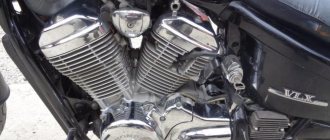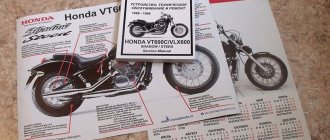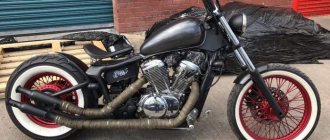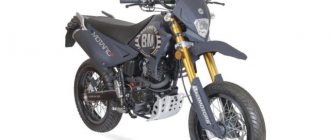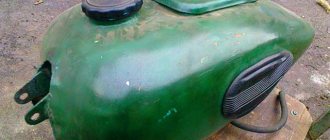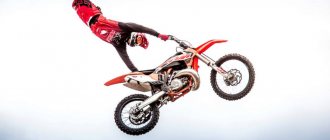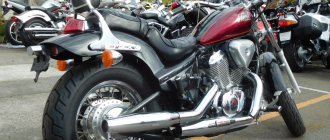2Sult › Blog › Building a Bobber (how two crooked motorcycles were remade) Part 1
I welcome you to my personal blog, there is no Camaro here, which means it’s not very interesting... Although my equipment will also appear here, which means that there is a small chance of getting a couple of likes))
Part one, purchase. (Ps - a lot of letters)
Until recently, I didn't know much about motorcycles. There are choppers and sports bikes, as well as motocross bikes. This is where the division of motorcycles ended for me. After my friend Gleb GlebRublev bought a motorcycle last summer, I began to delve deeper into the study . Plus, a friend’s purchase of a motorcycle spurred the desire to buy something two-wheeled myself.
. My friend spurred my desire to buy a motorcycle very much, I sincerely envied Gleb, in a good way of course)
So, back to the topic. I like choppers/cruisers, I don't like sports. Accordingly, the choice was among them. Of course, I really wanted (and want) a Harley, Sportster 48, but a number of reasons led me away from buying this bike. Then I discovered the class of bobbers and cafe racers, and began to study the market on this topic...
September. On Auto.ru I came across an ad - suzuki intruder, ’94, volume 400, 75 thousand rubles, according to the photo, excellent condition.
With an average price of 120 thousand for this bike, the ad surprised me. BUT it was quite easy to check, the address indicated in the form is right next to my work. I called Gleb and said let’s go have a look. I immediately called the owner of the motorcycle and arranged a meeting.
I went to see him twice. The first one is to look, the second one is to buy
. The motorcycle turned out to be really in excellent condition, as far as possible for a motorcycle born in 1994, the price is low for reasons that I will not name, it’s personal enough.
Next is the most interesting thing at this stage. I have almost no experience, so Gleb and I went to the site near his house, where he began to tell me all the basics and where I got behind the wheel of my own motorcycle for the first time. I left for the city at the end of the second day, the training was too easy for me, I listened very carefully to my friend and did absolutely everything he told me. Of course, I didn’t have any excessive confidence in my abilities, since I was aware that I had no experience and that this was a rather dangerous type of transport. I approached my studies quite responsibly; for the first few days I traveled only with Gleb, under his cover.
My motorcycle was hung with some kind of panniers, it had some kind of wretched windshield, it had a wretched back seat and backrest, in short, everything that infuriates me wildly. So the first thing I did was take off all the panniers and racks and throw them to hell.
So I became the owner of a motorcycle that could be converted into a Bobber, with my own hands. Without any experience or any specific knowledge. Gleb volunteered to help me, for which I thank him very much!
It turned out to be a great hobby, work, entertainment and relaxation, in which I, my close friend, and most importantly, my father participate.
Thank you all for your attention, the second part will be coming soon.
Source
The whole truth about “Garage Custom” from scratch using the example of a bobber from Honda Steed
Many of us, driven by a desire for a sense of beauty, have more than once thought about any alterations and modifications to our motorcycle. However, possibilities do not always catch up with desires, which sometimes leads to a lot of problems, which I would like to talk about today, using the example of my bobber from Honda Steed.
Hi, gang!
When people ask me what kind of motorcycle I have, I try to move all the gears of my brain at once to give an answer that doesn’t lead to more questions. On the one hand, this is a 1992 Honda Steed 600, which I bought on New Year's Eve for one sole purpose - to become a bobber. And it’s one thing - when you talk to someone who is a motorcyclist himself and after the words: “homemade bobber from Steed,” this person draws a clear picture of this motorcycle, nodding his head approvingly (or not, but the essence is still clear to him). It’s a completely different matter when the conversation is with a person who knows about motorcycles only from his drunken youth in the village, or even doesn’t understand anything at all. The consciousness of such an average person may simply be broken by the formulation indicated above, after which the saliva of confusion may begin to come out of his mouth, and his eyes will move along different axes. Many will say: so why engage in dialogue with such people? But what should I do if I am not yet so experienced in the motorcycle world, and I am still surrounded not only by bikers.
It would seem that there is a wonderful word “custom”, a word that can justify any intervention in the design of a motorcycle, at least to oneself. But, again, even this word is not familiar to everyone, and sometimes the gears in the head misfire, recklessly sending it out of the mouth, giving rise to a lot of awkward questions that it is advisable to answer so as not to offend the interlocutor. After all, you still have to work/communicate/interact/live with him.
“Custom? And what is it?". But indeed, it is not so easy to answer this question unambiguously. There are workshops that receive money for their work. Motorcycle tuning is their life and bread. Do they make custom? Definitely yes. And then there are us guys who, after watching enough movies and pictures on the Internet, decide to pick up a grinder and saw, cook, saw again, and so on. Is this considered custom? Well, in theory, yes. Is it fair to put professional workshops on the same level as garage “customizers?” Probably not…
And in the meantime, while you are going through this whole thought process in your head, your interlocutor already has time to go get coffee, smoke a cigarette and come back. Therefore, I simply say: “Garage custom.”
The story of my “beaver love” began long before the acquisition of Steed. Or rather, the Honda Steed was the first motorcycle that I had my eye on in principle. And when I found out what a bobber from such a motorcycle looks like, I also found my first goal. And so, five motorcycles later, the last of which was wrapped around a turning car (he also became the sponsor of the bobber’s construction), I began to walk towards my goal. First, a donor was found - which was purchased for 120,000 rubles in the middle of winter.
And here was the first mistake of the “Garage Customizer”: “cutting leads to falling.” Advice for beginners - do not skimp on the donor, components and services. What could have been done for relatively little money with minimal effort turned into a terrible epic with a lot of fuss and nerves. In my case, the main mistake turned out to be a too tired motorcycle, which cannot be completely restored. But first things first.
Once I already tried to do something with my own hands. That time, my victim was a 1989 Honda Bros 400. I bought it in the middle of the season due to the death of the main motorcycle, with the goal of riding me until the end of the season. However, I suddenly became wedged, and I wanted to try to make a “Scrambler” out of it. The lack of skills, equipment and common sense led to the realization that the base was unsuitable, and the project was curtailed, re-qualifying as a meticulous restoration to factory condition and subsequent sale.
In the case of Steed, the decision was made to immediately cross the point of no return, so that there were no longer any options to move away from what was planned. Therefore, on the same day that the motorcycle arrived at the base, its ass was cut off under the spine, which gave rise to a whole wave of jokes from those around him. This was already the second mistake, but from a design point of view. Since I abandoned the idea of making a “cracker”, underestimation was not an option for me. Which, in turn, would leave an ugly “hole” between the rear wheel and the future seat, which had to be covered somehow. In parallel with the thoughts, further disassembly was underway, and a creative crisis ensued. When faced with a series of difficulties, it is quite easy to go off the intended path, falling into the abyss of despair.
And at this stage, thanks to my faithful friends who simply did not let me do this, rushing headlong into the project and taking on the lion's share of the troubles, which I would not have been destined to cope with any time soon. For the first time in all the time we were working on the motorcycle, there was an action plan with specific tasks, instead of chaotic shredding of iron.
To start, the subframe that was sawn off on the first day was welded back in place with the goal of cutting it a little further, leaving “horns” that would cover the very gap that I didn’t like, and also act as brackets for two removable flagpoles . At the same time, I was preparing the engine for painting, pouring it liberally with paint remover and cleaning it with a wire brush.
When the “horns” took the form that I imagined, it was time to work on the rear wing. Since the prices for making wings from a sheet of iron on the English wheel were “biting”, it was decided to take the path of less resistance and make a wing from a ready-made one from another motorcycle. Scientific research led me to a garage cooperative, where a rear wing from the Dnepr MT was purchased, which, after a series of alterations, took its rightful place on the motorcycle.
The front one was made from the original one by shortening it. The seat was bent with a sledgehammer in a vice made of 6 mm steel sheet. At the same time, work was going on on the steering wheel, seat, a number of small details and preparing everything for sending for powder painting (except for the engine, I decided to paint it myself). When the entire motorcycle was smeared in an even layer throughout the workshop, everything was collected in boxes and sent to the sandblaster with powder. And here the very first mistake surfaced again: the work was entrusted to a person who did not want to use his head once again and thereby caused a lot of trouble, which was due to the attractive price tag for the work.
When we arrived to pick up the parts and frame, everything looked quite civilized, all the holes and threads were sealed (by agreement, the elements circled in yellow could not be touched), but the valve covers and engine covers had noticeable potholes under the paint, which was due to their strong corrosion from the very beginning. In the areas of the outbreaks, the metal softened and sandblasting only made them deeper, which again indicates the need to select a donor in the best condition from the beginning.
Problems began when the valuable cargo was delivered to the base. Many people are familiar with the problem of searching for and selecting bearings for a steering wheel. Many of them are very difficult to find, but the ones I had looked very decent and there was no play in them. Therefore, it was decided to try to save them so as not to prolong the already protracted project. When we started peeling off the reinforced tape that covered all critical areas, the degree of indignation only grew. All mating planes, all bearing races and much more were simply damaged by sand. This fact not only added additional costs, but also greatly delayed the assembly stage due to the need and search for the necessary bearings.
However, we managed even with this and started assembling. The sandblaster's jambs were opened one after another, but everything was solved one way or another. And so, the pendulum and motor took their rightful place. And the painter had just finished working on all the other parts of the motorcycle. The final stage has begun, and despite the fact that there is no point in describing everything due to the simplicity of the tasks (clean the bolt, put on a new clamp, make a gasket, run the thread, stretch the wire), this stage was very energy-consuming and drained the last of our strength.
Day after day, after working full time, I had to go to the workshop, finishing the motorcycle until late at night. And now, the moment has come. The first start of the engine, the first meters under its own power. The time has come to move from one workshop to another for a number of reasons. First trip to the city, without turn signals, mirrors, brakes. As I walked, brake fluid flew into the open visor of the helmet, abundantly spraying my happy face with burning drops. We did it, we got what we wanted.
This motorcycle brought together many people who contributed to it. Their names will be immortalized on a brass plaque at the front of the bike, the installation of which will mark the final stage of the project. Yes, this bike still has a lot of problems like air leaks, unstable idling, no brakes, power wiring problems, and some parts are simply not finished yet. But that’s the point of “Garage Custom.” There is no client here who needs to present a finished product within a given time; there are no requirements here other than his own “I want”. But here there will always be that same “lamp” spirit of alterations with your own hands and the sweetest taste in the world: the taste of victory.
In such projects, the issue of opportunity is always in the foreground, which in turn consists of finances and experience. Experience comes with time, and no one is born with a golden wrench in their hands. Step by step, from simple to complex, we are improving and moving towards the goal. I have been accused many times: “You have seven Fridays a week!” Yes, yes and yes! Because this is precisely the evidence of progress. And, for example, if just yesterday I could not sleep, because of constant thoughts about the fuse box, which, without their original side covers, were exposed to the elements of nature, exposed to the wind, dust and rain, then today I already know that the solution that it was literally just in my head - it’s no longer necessary, because you can just take a sheet of iron and bend it into a box in which everything will be placed.
Just yesterday I couldn’t even think that this was possible, and then they poked my nose, gave me a grinder and said “Do it!” And I did. And now this seemingly trifle has become almost the crown of the design of the entire motorcycle, the starting point with which experience comes, and it, in turn, will certainly influence everything you do next. And the projects themselves, built with their own hands, carry inspiration for everyone else. After all, if we could do it, so can you. The main thing is not to overestimate your capabilities. This is my third and biggest mistake. And I am grateful to those who helped me solve this mistake, but not everyone has such people. Therefore, sensibly evaluate yourself, your experience, knowledge and, of course, your finances. From the very beginning, I was overcome with excitement: “Is it possible to make such a motorcycle by investing 30 thousand rubles in it, as everyone around says?” It’s possible, for sure, but will the result meet your expectations? Personally, having crossed the barrier of 30 thousand rubles at the very beginning, I simply stopped counting. I became completely uninterested in how much something costs. I wanted results, and I couldn't have achieved them by skimping on every screw. We live in a time when everything can be bought from China at absolutely ridiculous price tags. But believe me, it’s not 2005 now, and you can’t fool anyone with Chinese fire, and the project will turn out to be as ridiculous as the costs for it. And no, don’t think, I’m not a prude, I’m not trying to deceive anyone by proving that it’s not cheap. It happens, but not everywhere. The fasteners from the broken Desperado perfectly found their place throughout the bobber, the exhaust was bought in garages, a couple of little things still came from China, but it is always important to maintain a sense of beauty without skimping on your taste. After all, I repeat, the sweetest thing you can get in the end is the taste of victory, and it is either genuine, valuable, intoxicating, or it is not there at all and it is all just self-deception. No, this does not mean that either do it difficult and expensive, or don’t do it. Do it, just start simple. From what experience will give you. It will teach you how to save money, work effectively, and use your time. And before you even have time to look back, you will be finishing your tenth serious project, and your work will be talked about on every corner. #honda #hondasteed
Popular custom Ural-bobber models
Ural M67-36 Bobber
Donor: Ural M67-36 1979.
Stages of work:
Ural-Bobber from Kaliningrad
Production time: 1.5 years. Authors of the project: Vyacheslav Kh. and Grigory Dolotov.
Stages of work:
Ural-bobber from Novosibirsk
Donor: Ural M72, 1954. Author of the project: Roman Molchanov.
What was done?
Ural Bobber from the classic Ural 1993
Donor: Ural, manufactured in 1993. Custom production time: 2.5 months.
How was the process?
First, the motorcycle was disassembled; many of the bolts could not be unscrewed and were cut off with a grinder. After this, the frame was redone, the covers were removed from the fork and parts were found such as:
All parts are sanded, puttied and primed. This process took almost a month. The motorcycle has been painted.
Next, the assembly of the motorcycle began, during which the mounts were welded, something was sharpened and adjusted to size, and also polished. Made a saddle with a bicycle spring and an exhaust pipe.
Ural-bobber Zeus
Author: Albert. Project cost: 60,000 rubles (the Ural motorcycle cost 15,000).
The front part of the frame and the engine remain from the original motorcycle. All other parts were made or modified by hand:
Ural M72-bobber
Time to create a custom: 2 weeks.
Main features: engine with electronic ignition, Ford Focus wheels, glove compartment.
Source
Step-by-step instruction
Before you disassemble an old motorcycle, you need to decide what you want. To do this, look for as much information as possible (operating principles, photographs, drawings, etc.). It’s not difficult to make a chopper from the Urals with your own hands, but you won’t be able to find the necessary parts and tools in any store. Therefore, decide in advance what kind of design you are going to make. After organizing your workplace, you can start working:
- First of all, it is necessary to create a drawing of the future unit. A visual representation of the motorcycle will help you navigate the correct assembly. It is best to create a drawing in which all dimensions will be indicated. This will help not so much you as specialists who probably do not understand what you want to achieve.
- Next, you need to find masters in the area that will be beyond your strength. For example, not everyone has welding or grinding . When looking for specialists, you can look at the equipment production plant. For a small fee, workers will make a good, durable device. Explain to them that you want to make a chopper with your own hands; the drawings will help them understand how you imagine the future device.
- The basis of a chopper can be any bike. The Soviet motorcycle is ideal not only for its style, but also for the cheap cost of parts. In some cases, you don’t even have to spend money on buying new spare parts. For example, lighting fixtures or carburetor tanks can be removed from old, unusable equipment.
- After determining the work plan, begin disassembling the bike. Sort the parts right away. Place all small and replaceable parts in one place. Clean the parts that will be installed in the motorcycle thoroughly.
- After cleaning the mechanisms, have them painted and chrome-plated. At this time, you can putty large parts yourself, such as the fuel tank, fenders and protective screens.
- Now you need to polish all engine parts. This primarily applies to the axle, crankcase, gearbox and exhaust system.
- If problems are found in the engine, it is necessary to replace all faulty parts, or better yet, overhaul the engine.
- Leather accessories are quite easy to make yourself. It will look stylish and not expensive.
- After the specialists have welded the correct frame for you, and all the parts have been painted and replaced, you can begin assembly.
Bobber Mason continued...
So, I’ll tell you a little about my motorcycle. I started making it in 2014, successfully purchased a decent amount of parts, now it all costs more, or you can’t buy it at all, like this rear chrome-plated rim in the photo from the Ural Wolf motorcycle, they haven’t been produced for a long time. I tell you what and how it was done in the video, if anyone is interested)
And about sawing wings at home
I'm waiting for your fiery comments)
Triumph Bonneville Bobber Black
Bobber Rough Crafts Dyna Guerilla
Customizer Winston Yeh of Rough Crafts is a talented customizer who specializes in customizing Harley motorcycles. He works in his workshop in Taipei, Taiwan. Winston pays great attention to the design of his motorcycles and the fine details, resulting in impeccable designs.
Dyna Guerilla Project Details:
— Harley-Davidson Fat Bob 2009 donor
— Progressive rear shock absorbers and Progressive lowering kit for the front suspension
- fork repainted titanium color
— 16-inch Arlen Ness wheels
— tires Coker/Beck Cycle Blackwall 5.00
— Lyndall Brakes composite brake discs, milled calipers
— Rough Crafts Fighter steering wheel
- Rough Crafts handles and risers
- Other Rough Crafts components: foot controls, tank cap, fuel tank, saddle, etc.
— Harley-Davidson Forty-Eight headlight
- Rough Crafts Guerilla exhaust
A little history. Bobbers.
A little history about bobber motorcycles.
The name itself suggests that everything unnecessary is removed from the motorcycle, it is sort of trimmed (English: bob - short haircut), this was due to the desire to win in street racing, a lightweight motorcycle is faster. Bobbers are, let’s say, a more “boyish” and high-speed version of a motorcycle.
In the 30s, the first bobbers began to be born in California (then they were also called bobers - stripped down), they were made from Crocer motorcycles, these motorcycles, unlike other manufacturers in the USA, were the fastest and therefore were leaders among young people at that time. time. The Second World War began and the state demanded powerful motorcycles; Harley-Davidson was lucky and signed a contract with them. Well, after the war they no longer had competitors.
European youth returning after the war took up the task of converting US heavy motorcycles obtained during the war into light and manageable ones, and here the beaver experienced its rebirth. American youth who returned from the war after 1945 also took up the task of remaking their heavy motorcycles for racing and more.
Source
Lose weight: A guide to lightweight American motorcycles - bobbers
American veterans returning from the fronts of World War II to a deafeningly quiet peaceful life quickly found something to satisfy their adrenaline hunger. They gathered in motorcycle clubs, traveled around the country and, of course, organized races. Thanks to them, bobbers were born - motorcycles that could take their owners to first place in competitions and would be more or less suitable for everyday use.
But times are changing, and today it’s only possible to imagine a bobber plowing a dirt oval track in a deep skid only in a nightmare. These motorcycles are built by craftsmen on individual projects using vintage components, cost a lot of money and are cherished by their owners in every possible way. You can learn about how they came to their form, what a “suicide handle” is, and what a proper bobber driver never leaves his garage without in this FURFUR article.
The bobber style took shape precisely in post-war America, although its origins arose even before World War II in the same States. More and more people switched to two wheels, united in clubs and organized amateur competitions. But the raging Great Depression at that time and chronic lack of money did not allow enthusiasts to buy a “combat” motorcycle for track days in addition to a motorcycle for every day. We had to race in the same thing we used to drive to work or to visit a neighboring state.
1. A representative of the 13 Rebels motorcycle club, founded by World War II veterans, and his bobber. 2. Jack Nicholson on a Harley bobber. 3. Poster for the film about the motorcycle gang “Troublemakers.” This is what Jack Nicholson wore in his bobber. 4. Participant in one of the races. 5. Still from the film “Savage” with Marlon Brando.
There was only one way to reforge an old-fashioned and very heavy American motorcycle into a conqueror of unpaved (asphalt was not everywhere in the USA in those days) racing ovals - by unscrewing and cutting off everything unnecessary from it. First of all, the front fenders flew onto the garage floor. The wings were made of metal, weighed a lot and prevented the wheel from rotating due to the fact that dirt accumulated between the wing and the tire on the track.
| Following the fender were headlights, rearview mirrors, instrument panels, horns, windshields, passenger seats, running boards, and even front brake assemblies. Then the owner armed himself with a hacksaw and metal scissors and literally “shaved” (from the English verb to bob - “to cut” - and the name of this type of motorcycle came from) his car to a completely obscene state. But the bike lost a couple of tens of kilograms at once. Even Harleys with low-speed Flathead engines acquired quite sporting agility in skillful hands. And there’s nothing to say about the lighter and faster Crocker bikes. | Custom bike on the cover of Marvel's Sgt. Fury and His Howling Commandos" |
The bobber theme received an exciting continuation after the war. Veterans who returned from the fronts brought back with them the experience of turning screws and impressions of European motorcycles - as a rule, faster, lighter and suitable for high speeds and competitions. The achievements of the European school of motorcycle engineering have begun to be grafted onto American soil.
Speed-conscious bobber owners looked for examples of the best implementation of a particular component on European motorcycles and adapted the components for American cars. More efficient and lighter brakes were installed, more efficient carburetors were installed to achieve more power, engine cylinders were bored out, the heavy standard exhaust system was thrown out and replaced with cuttings of a thin-walled pipe, which did not seem to dampen, but rather intensified the roar of the engine.
Particularly handy riders completely welded the motorcycle frames and installed a more powerful engine from a model of a higher class into the compact, lean chassis. Although the “heart transplant” maneuver for bobbers is a rather exceptional case and does not quite fit into the canons of this style.
The canons of bobber style consist of several characteristic features. As befits a sports device, every design change is dictated by purely utilitarian considerations. This distinguishes bobbers from their closest relatives, custom ones, whose owners love to hang trinkets of dubious usefulness on their motorcycles.
| The first thing that catches your eye in the appearance of a bobber is the wide handlebar, which is convenient for guiding the motorcycle while power sliding along a dirt track. Then - a “springer” type fork (or its version “girder”) - double, with a system of levers and an elastic element in the form of a spring. It is simple to manufacture, lightweight, rigid and easy to maintain - all critical components are easily accessible for lubrication and adjustment. In addition, the “springer” works great at large wheel departure angles. | The springer fork is one of the canonical design elements of a real bobber |
Considering that the basis for bobbers is often taken from custom frames with their considerable reach, this is a highly justified technical solution.
The rear drum brake, chain drive, front and rear wheels of the same size (if the rear one is worn out, you can swap it with the front one and continue racing), a spring-loaded “frog” driver’s seat and a complete absence of chrome look ideologically correct on a bobber.
Masculine to the core, the bobber came back into fashion ten to fifteen years ago in the USA, Europe and Japan. Projects in this style made a splash at customizing competitions, appeared on the covers of glossy magazines and photo reports from the lives of celebrities. Nowadays there is a whole industry for those who want to build a bobber themselves or get one from a custom guru. Absolutely everything is produced and sold - from drawings for self-manufacturing frames and the smallest spare parts to pre-war H.-D engines. Flathead to fully restored power units, rolling chassis kits (frame and wheels) and do-it-yourself kits, which, with proper assembly and subsequent painting, turn into a full-fledged bobber.
Among the huge number of remakes, there are also vintage spare parts, which, like cherries on a cake, should crown a device made with your own hands. They ask for a lot of money for such components.
However, replica parts are not far behind. For example, one Cocker White Wall tire (with a white stripe on the sidewall) per motorcycle costs more than $200. For the most radical fans of the style, there are even kits for converting the usual gear change mechanism into a “suicide handle”. For the opportunity to voluntarily break one's neck, they ask for 300–400 dollars.
Rolling chassis kits start at $1,500. Self-assembly kits cost at least 10 thousand and are addressed to enthusiastic fans of turning nuts in the garage. | With a “suicide handle,” changing gears on a motorcycle resembles a similar process in a car. Only a hundred times more dangerous. |
The device got its nickname (suicide shifter) for a specific process of changing gears: you need to press the clutch pedal with your foot, and change gears with a lever next to the gas tank. You need to operate the lever by removing your left hand from the steering wheel. Needless to say, such a stunt while accelerating at full throttle often ended in a fall onto a dirt track, perhaps even under the wheels of rivals. Modern riders, out of habit, are generally unable to tame such a sophisticated system.
BOBBER FROM "URAL"
Harley of any year of manufacture is by no means the only donor of components and assemblies for the construction of bobbers. Insanely stylish devices are built around vintage European and even Japanese engines. Alas, in Russia old air vents from the Honda CB500 and Yamaha XS650 of the 1970s cannot be found during the day. There is nothing to even talk about more sophisticated options like BSA and Triumph. Domestic realities offer only a boxer engine from Ural. However, if your hands grow from the right place, then you can despise all the canons and give out your own interpretation of the bobber style to the envy of everyone. Like this creation of a Kaliningrad master.
It's hard to believe that this beauty was an ancient Ural in a past life. The work to turn it into a bobber took two years and was completed an hour before the end of the motorcycle season.
WHAT A BOBBER DRIVER SHOULD LOOK LIKE
The film "Savage" with the young Marlon Brando closed all questions about what a person on a motorcycle should look like. Leather biker jackets, jeans, gloves, high boots or shoes, emblems, badges and stripes are produced by billions of large and small companies. We have already written about the history of one of the most famous brands in the field of motorcycle fashion, so we will not dwell on the features of biker jackets.
Helmets made by Biltwell
And although Marlon Brando's character in The Wild One, Johnny, was never seen wearing a helmet, a helmet is a mandatory attribute. At least from a safety point of view. Biltwell makes good, proper looking bowler helmets. She also produces “canned” glasses. Both pieces of equipment look like something out of a picture from the fifties, but are made using modern technology. After all, even Brad Pitt recognizes the need to ride with a protected head - he has never been seen leaving his garage in a bobber without the appropriate headgear.
